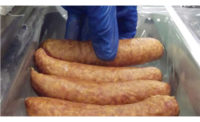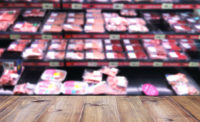The standard method of determining microbial populations in meats involves time-consuming microbial plate counts. Because of this there is interest in estimating microbial populations by faster instrument measurements, such as dissolved CO2.
Therefore, to see if instrument measurements work for estimating microbial populations, the objectives of this study were to determine the dissolved CO2 and O2 concentrations in the purge of vacuum-packaged (VP) pork chops over 60 days of storage and how they relate to microbial populations and shelf life.
Sixty pork chops purchased from a retail store were placed into 20 vacuum packages with a Teflon stand with two glass tubesinserted into each package to collect the purge. The packages were stored at 4°C, and two packages were sampled on days 0, 5, 15, 30, 45 and 60. The dissolved CO2 and O2 concentrations were measured and microbiological analysis was performed on the purge and pork chops (surface) samples to determine total bacterial (APC), lactic acid bacteria (LAB), Enterobacteriaceae, and Brochothrix thermosphacta populations.
The APC and LAB populations increased to log10 8 CFU/cm2, while Enterobacteriaceae and B. thermosphacta were log10 6.6 and log10 4.5 CFU/cm2, respectively, after 60 days for surface samples. For purge samples, the APC and LAB populations increased to log10 8 CFU/mL, Enterobacteriaceae reached log10 6 CFU/mL, and B. thermosphacta reached log10 3.9 CFU/mL. The dissolved O2 concentration decreased from 8.31 to 0.11 mg/L while the dissolved CO2 concentration increased from 0 to 3,000 mg/L inside the purge of VP pork during the 60-day storage period.
The bacteria in the VP pork increased the dissolved CO2 and decreased the dissolved O2 concentrations over time. In particular, LAB produce CO2 as a byproduct of their metabolism and are not affected by CO2 levels, so dissolved CO2 can be used to estimate LAB populations.
This led to the development of two mathematical models because the surface and purge samples significantly differed in population numbers (p<0.05). The model for the surface samples is log10 LAB CFU = 4.2 + [(3.5 x 10-3)*(dissolved CO2)] + [(-7.2 x 10-7)*(dissolved CO2)2] with an adjusted R2 of 0.89. The purge model is log10 LAB CFU = 3.9 + [(2.9 x 10-3)*(dissolved CO2)] + [(-5.3 x 10-7)*(dissolved CO2)2] with an adjusted R2 value of 0.87. These models have acceptable R2 values (above 0.80) and a good fit despite only using limited data (three replications). These models only estimate microbial populations, not sensory shelf life, and are limited to VP pork chops stored at 4°C.
Despite these limitations, these models promisingly suggest that shelf-life models can be developed from an instrument measurement, such as dissolved CO2 concentrations. These models also provide an indication of a “real-time” measurement of shelf life, which is an improvement upon the three-day, “historical” data delivered currently by plate count methods.
More research is needed to validate the accuracy of these models, but this study demonstrates the meat industry could begin to use faster instrument measurements instead of plate count methods to evaluate the shelf life of a product.




Report Abusive Comment